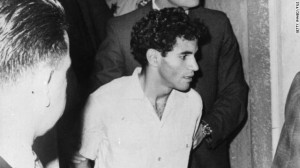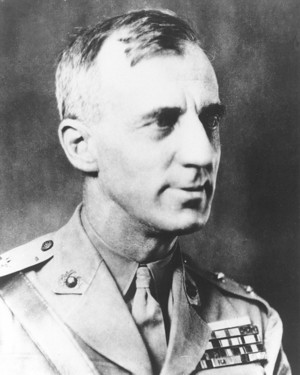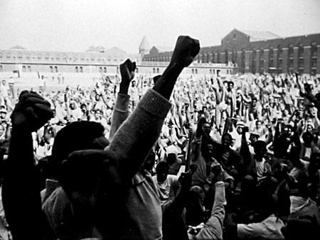Alex Constantine - December 20, 2007
 A 19th-century image shows federal troops employing several forms of torture. One man stood on a barrel for several hours; another carried a large log, his leg weighted with a ball and chain; a third was bound to a tree with his arms raised above his head; a fourth sat on the ground, tied. (Corbis)
A 19th-century image shows federal troops employing several forms of torture. One man stood on a barrel for several hours; another carried a large log, his leg weighted with a ball and chain; a third was bound to a tree with his arms raised above his head; a fourth sat on the ground, tied. (Corbis)
" ... Torture isn't an alien force invading our democracy from the benighted realms of dictatorships. In fact, it is the democracies that have been the real innovators in 20th-century torture. Britain, France, and the United States were perfecting new forms of torture long before the CIA even existed. It might make Americans uncomfortable, but the modern repertoire of torture is mainly a democratic innovation. ... "
••••••••
Torture, American style
The surprising force behind torture: democracies
Boston Globe
December 16, 2007
A 19th-century image shows federal troops employing several forms of torture. One man stood on a barrel for several hours; another carried a large log, his leg weighted with a ball and chain; a third was bound to a tree with his arms raised above his head; a fourth sat on the ground, tied. (Corbis)
By Darius Rejali
December 16, 2007
NEARLY EVERY MONTH, it seems, news reports carry disturbing revelations about torture by American soldiers, intelligence officers, or allies. Just by reading the news we learn things we never wanted to know about waterboarding, forced standing for hours, and sleep deprivation; most recently the CIA has destroyed videotapes showing a suspected terrorist being interrogated with techniques that an agent called torture.
Behind these disclosures, as they reach our ears, runs a powerful current of disbelief and shock: it is hard to imagine that such things would be done by Americans.
We think torture is mainly the province of dictators and juntas - the kind of thing that happens behind the iron doors of repressive regimes. In a democracy, with open courts and a free press, torture should be a relic. In the words of an American World War II poster, torture is "the method of the enemy."
But a closer look at the modern history of torture suggests that exactly the opposite is true. Torture isn't an alien force invading our democracy from the benighted realms of dictatorships. In fact, it is the democracies that have been the real innovators in 20th-century torture. Britain, France, and the United States were perfecting new forms of torture long before the CIA even existed. It might make Americans uncomfortable, but the modern repertoire of torture is mainly a democratic innovation.
In one instance after another, democracies developed new torture techniques, refined them, and then exported them to more authoritarian regimes. Americans didn't just develop electric power; they invented the first electrotorture devices and used them in police stations from Arkansas to Seattle. Magneto torture, a technique favored by the Nazis involving a portable generator, was actually developed and spread by the French. Waterboarding and forced standing owe their wide use to the Americans and British.
None of this is to say that democracies have a worse record of torture than authoritarian states: dictators deserve their reputation for violence and cruelty. But the role of democracies is central. Painful as it is to confront, knowing how - and why - democracies have played such an important role in torture also has a hopeful side: it suggests that democracies can also halt torture. In fact, they have a special responsibility to do so.
. . .
The word "torture" still evokes medieval images - the rack, the iron maiden, thumbscrews. Authoritarian states historically chose torture techniques that were as painful as possible, and torturers often scarred their victims deliberately, using their damaged bodies as a deterrent and an advertisement of state power. Kings used torture to demonstrate that they could take lives or show mercy as they willed.
For centuries, the whip was the preferred tool of state torture, and some were nastier than others. The Great Russian Knout, for example, had a hook on the end of it that tore out chunks of flesh with each blow. Even the Nazis, well into the era of modern torture, favored whips, as they scarred their way across thousands of victims in prisons and concentration camps during World War II.
Page 2 of 4 --
In recent times states have outlawed open spectacles of torture, and torture has ceased to be an exhibit of kingly power. But its basic uses remain the same: extracting information, forcing false confessions, and keeping prisoners docile and compliant.
So torture hasn't really disappeared in the modern age. What have disappeared are forms of torture that leave marks. The police, military investigators, and governments in democratic societies can count on the press and people watching. They know that if a prisoner can't show any marks of torture, people are far less likely to believe his or her story. So as societies have become more open, the art of torture has crept underground and evolved into the chilling new forms - often undetectable - that define torture today.
Take electrotorture. In the early days of electric power, most authorities avoided using electricity for torture because it was too dangerous: it tended to kill its victims, and dead subjects yield no information. But in 1899, two research teams, one American and one Swiss, correctly identified the biological processes that caused electrical death. This knowledge proved to be critical: A proper torture device, it appeared, had to deliver painful high voltages with low amperage.
The earliest recorded electortorture device was an American machine called the "hummingbird" (1908), likely nicknamed because it hummed with electrical current as it was applied to the body. We know little about it; it appears in the writings of the anarchist philosopher Emma Goldman, who received letters from prisoners describing its use.
Early 20th-century America was a breeding ground for new ideas in electric torture, many documented by American Bar Association investigators in their 1931 Report on Lawlessness in Law Enforcement. Between 1922 and 1926, the Seattle police chief got his confessions from a cell with a wall-to-wall electrified carpet. "The prisoner leaps, screaming in agony, into the air....It is not fatal, its effects are not lasting, and it leaves no marks," remarked the ABA report. And until 1929, the police in Helena, Ark., used an improvised electrical chair to extract confessions. At the time, the sheriff testified that the chair came with other office furniture, and he had inherited it from "a long line of former county sheriffs."
Still, these devices were rather crude compared with what electrotorture would become. The most famous electrotorture device was adjustable, portable, and based on the magneto, a simple generator that produces a high-voltage spark. The idea of using a magneto generator for torture came to be closely associated with the Nazis, who employed it ruthlessly in France and Belgium during World War II. But it wasn't the Germans who developed it: It was the French colonial police, the Sûreté, who pioneered the technique and used it throughout the 1930s fighting Vietnamese nationalists. The Nazis learned about the technology from a Vichy police officer, Inspector Marty of Toulouse, in 1942.
Although the Gestapo carried magneto torture to Paris and Belgium, the key distributors of magneto torture after the war were the United States and France. The French resumed magneto torture in Vietnam as early as 1947, passing it to the South Vietnamese, who passed the technique to American military interrogators during the Vietnam War. The Americans introduced magneto torture into Brazil in the late 1960s, and - just as the French had - the Americans eventually brought it home. Chicago police used magneto torture in the 1970s and 1980s to extract confessions. Most alleged incidents implicated Commander Jon Burge, a decorated veteran of the Vietnam War, and the detectives he supervised.
Electrotorture is only one example of how torture spreads via democracies. "Forced standing" is a technique used in the Soviet Union and made famous by the hooded men of Abu Ghraib: They were forced to stand for hours, balanced on a box with the threat of electric torture if they collapsed. It is not nearly as harmless as it sounds: Humans are not designed to stand utterly immobile, and accounts of the practice from Soviet-era victims and psychologists hired by the CIA describe immense pain.
Though forced standing is often associated with the interrogations of Stalin's secret police, the British had already refined the use of forced standing to intimidate and coerce prisoners. From 1910 to 1930, the practice was well known in Irish prisons and in British Indian penal colonies in the Andaman Islands in the Bay of Bengal. The British colonial police also used it in Mandatory Palestine, where they were especially concerned about keeping torture "clean": They knew scarred victims would create a scandal at home, and they knew the Nazi publicity machine would use evidence of torture for German advantage in the Middle East. Forced standing was also known in French contexts, and, in the United States, was a standard slave punishment that by the 1920s became part of American police interrogations and prison punishments. Before the 1930s, then, forced standing was the special province of democratic, not authoritarian states. W.G. Krivitsky, an Soviet secret police agent who defected, described Soviet interrogation techniques in 1939 as "improved by Stalin on the model of the latest American methods."
Some techniques date to well before the 20th century, but still owe their modern forms to the innovations of democratic states. The use of water in torture, for example, is quite old, but most historical autocrats liked to boil their prisoners. The modern use of waterboarding can be traced back to the Philippines, where in 1902 American troops were fighting the insurgency. Returning soldiers brought water torture back to their civilian jobs as policemen in the 1910s, and it soon appeared in military prisons and police stations in large cities and small towns, especially in the American South.
By the 1920s, one can find the full encyclopedia of modern water torture already written up in American newspaper accounts and trial transcripts. One technique involved choking the victim, either with full body immersion, by covering the face with a handkerchief, or simply ladling water on the face of a prisoner as he is tilted head downward. This is the basis of modern waterboarding, and it would subsequently appear worldwide.
When we examine the history of modern torture technique by technique - and there are dozens of examples - we find that newer, "cleaner" tortures first appear in conditions of public monitoring, usually in democratic states. It is only afterward that we find authoritarian states adopting them.
If the spread of torture techniques suggests a blurry line between "us" and "them," it also teaches that there's no real boundary between "there" and "here." It would be ignoring history to assume that what happens in an American-run prison in Iraq will stay in Iraq. Soldiers who learn torture techniques abroad get jobs as police when they return, and the new developments in torture you read about today could yet be employed in a neighborhood near you.
In Chicago, in the decade after Vietnam, the use of magnetos and other clean tortures left a disaster: At least 11 men were sentenced to death and many others given long-term prison sentences based on confessions extracted by torture, and in 2003, Governor George Ryan of Illinois commuted the death sentences of all 167 death row inmates. Earlier this month the City of Chicago agreed to pay nearly $20 million to settle lawsuits filed by four former death row inmates who claimed they were tortured and wrongly convicted.
Everything torture represents - intimidation, abuse of public trust, extraction of false confessions, the blind eye of officials - is antithetical to the way democratic societies are supposed to work. But "clean" torture, leaving few marks and practiced behind closed doors, permits a kind of public silence or amnesia. The facts of Abu Ghraib were already known through testimony, but there was no public outcry until the scandalous photographs made it impossible to ignore. Even after Abu Ghraib, lawyers for Guantánamo detainees doubted allegations of torture until FBI e-mails confirmed them. Today, American authorities still shy away from the T-word, preferring terms such as "abuse" and "enhanced interrogation."
The disturbing political implication of clean torture is that we are less likely to complain about violence if it is committed by stealth. Indeed, we are less likely even to have the opportunity to complain. This is not because we are indifferent (thought it is certainly possible), but because we are often uncertain whether violence occurred at all. We are, in effect, illiterate in stealth torture, and this has political consequences. When people can't speak intelligently about cruelty, they aren't likely to be able to protect themselves against tyranny at home.
Still, history shows that the cycle of torture can be broken. Americans put an end to most domestic torture between 1930 and 1950. We did this, in part, by exposing torture. The American Bar Association's 1931 report transformed American law and policing. The document was cited in court decisions; newspapers and true crime books drew on the group's investigations to educate the public as to what the modern face of torture was. And police chiefs instituted more checks on police behavior, including clear punishments for violations of the law and regular medical inspections for detainees.
Many European states now have reasonably good records on torture precisely because they call torture techniques by their proper names, give them histories, and institute strong domestic and international monitoring of police, prisons, and asylums. The French have a far better human rights record now than they did in the 1960s, even if it is by no means perfect. There is no reason why America cannot restore its own reputation.
The biggest surprise, perhaps, is that torturers care what the public thinks. For more than a century torturers have voted with their hands: Governments that continue to use torture have moved to techniques that leave little trace. The same public pressure - built on unequivocal disapproval - should eventually be able to bring an end to this sorry history. Strange as it may seem, torturers and their apologists really do care.
Darius Rejali, a professor of political science at Reed College, is the author of "Torture and Democracy," out this month.
http://www.boston.com/bostonglobe/ideas/articles/2007/12/16/torture_american_style/?page=4









No comments yet.